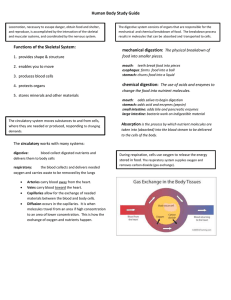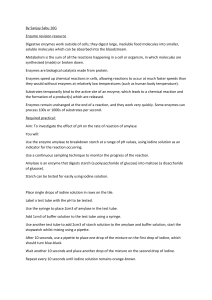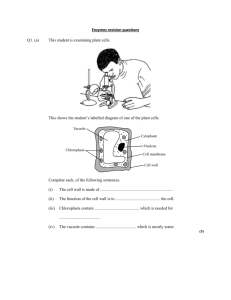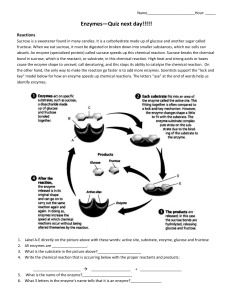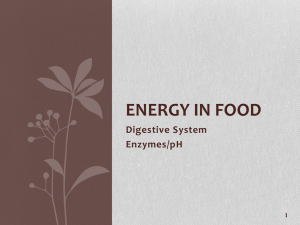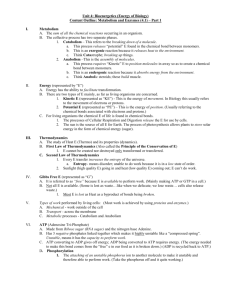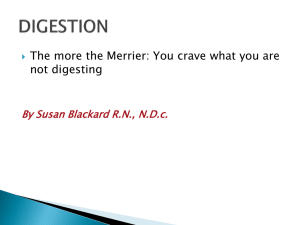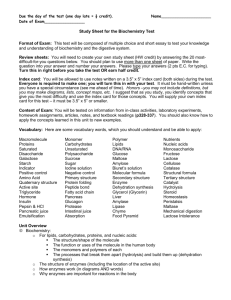Digestion & Enzymes
advertisement
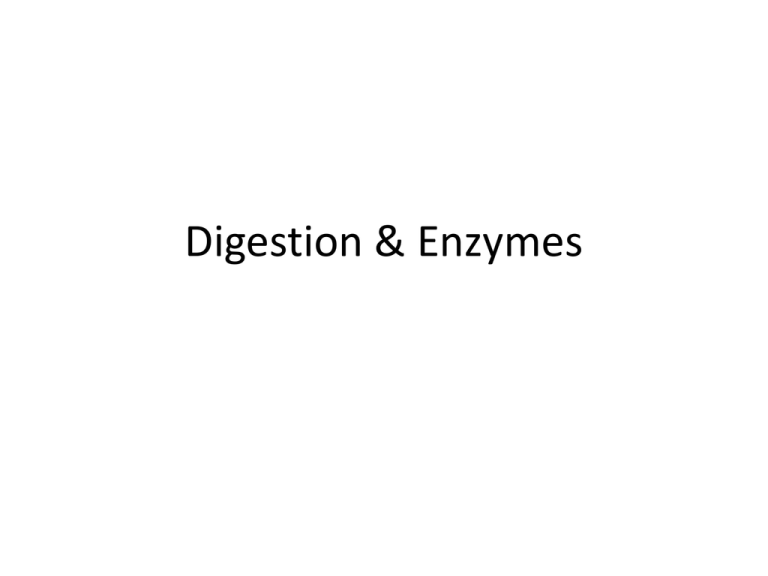
Digestion & Enzymes Stages of Nutrition 1. 2. 3. 4. 5. Ingestion Digestion Absorption Assimilation Egestion 1. Ingestion – Taking food into the mouth. 2. Digestion – The break down of food by teeth in the mouth and by chemicals in the stomach and small intestine. 3. Absorption – the movement of digested food from the small intestine into the blood. 4. Assimilation – the use of food by body cells for energy, growth and repair. 5. Egestion – the release of undigested food from the body. 1. The Mouth! There are two types of digestion • Chemical • Physical (Mechanical) http://www.medtropolis.com/vb ody.asp 1. Incisors – biting. 2. Canines – tearing. 3. Premolars – chewing. 4. Molars – grinding An Enzyme is a catalyst, made in the body, which speeds up a reaction without itself being used up in the reaction. The ENZYME works on a SUBSTRATE to make a PRODUCT Enzymes •Big food molecules can’t pass through cell walls. •ENZYMES are used to break up big molecules into small ones •These small molecules can pass through the wall of the small intestine into the blood. They then pass into cells and are used. Gut Blood Food is absorbed in the small intestine. The wall of the gut has lots of tiny holes in it. Small molecules such as glucose can pass into the blood but large molecules such as starch are left in the gut. Play animation NCE-MSTL BUT large molecules can be broken down into small molecules by enzymes. Enzymes are special proteins that act as biological catalysts. They speed up chemical reactions in the body. Digestive enzymes work by fixing onto the food molecule or substrate and breaking it into smaller molecules. NCE-MSTL Each enzyme fits onto a specific substrate ENZYME For example, amylase enzymes break down starch SUBSTRATE Play animation NCE-MSTL So… AMYLASE enzymes break down STARCH (CARBOHYDRATE) into MALTOSE. NCE-MSTL • Enzyme= • Substrate= • Product= Gut Blood Play animation NCE-MSTL These digestive enzymes allow food to be broken into small enough molecules to be absorbed from the gut into the blood. BUT large particles can be broken down into small particles. This is called DIGESTION The Oesophagus • The food is pushed down the oesophagus to the stomach by a wave of muscular action called peristalsis. The Stomach Muscular bag that holds 2 litres of food. Secretes hydrochloric acid. Makes digestive juices. Muscular walls churn the food making sure it’s all mixed. • After 2-3 hours churning it’s a runny liquid called chyme. • • • • The Small Intestine • Actually 6 m long! • Plays important roles in digestion and absorption • Two important liquids are added here: Pancreatic juices Bile Absorption • Digested food has to pass into the blood through the small intestine wall. • Well designed – thin lining, good blood supply and a VERY LARGE surface area. • It has a folded inner lining, millions of tiny villi Pancreas • Produces digestive enzymes • E.g. amylase Liver • After food has been absorbed into the blood, the food is taken to the liver. • The liver processes some of it, before it goes any further. • The food dissolved in plasma is the taken to other parts of the body. The Large Intestine. • Mainly fibre, dead cell, bacteria and water reach here! • As it moves along here most of the water is absorbed into the blood. • Faeces are stored in the rectum. • Eventually egested out of the anus, roughly 24 –48 hours after eating. Experiment write up • • • • • • • • • Questions: What did you use to test for starch? What colour showed that starch was present? What colour showed that starch was not present? What was the substrate in this experiment? What was the product in this experiment? Was this a fair test? Explain your answer. Where in the body is amylase found? Why did we use the waterbath at 37.5’C? • http://videos.howstuffworks.com/discovery/2 8649-assignment-discovery-breaking-downdigestion-video.htm • http://videos.howstuffworks.com/discoveryhealth/14062-body-invaders-digestiveproblems-video.htm • http://www.insidestory.iop.org/insidestory_fl ash1.html
